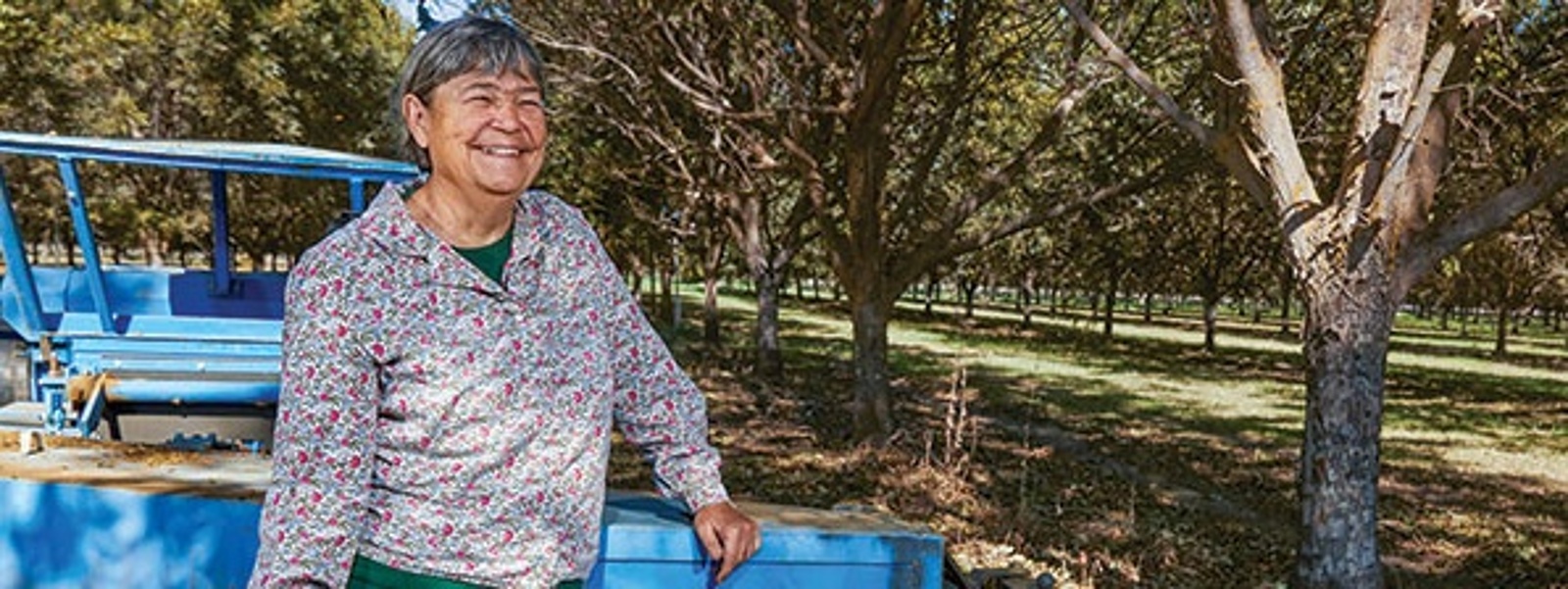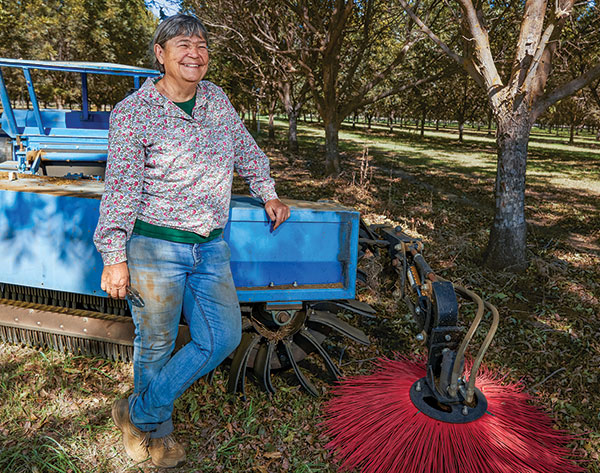Ask a farmer: Cracking open a surprise

November/December 2023 California Bountiful magazine

Yes, pecans are grown in California!
Story by Christine Souza
Photo by Fred Greaves
“PUH-CON” or “PEA-CAN”? No matter how you say it, the pecan stands proudly among California’s other commercially grown nuts: almonds, walnuts and pistachios.
The work to plant, grow, harvest and pack the rich, buttery nut is done by small-scale farmers statewide, who this year expect to produce a crop of 3 million pounds, according to the California Pecan Growers Association. Compare that to the state’s estimated almond crop of 2.6 billion pounds.
“Many people are just shocked to find out that there are pecans grown in California,” says Colusa County farmer Theresa Jeffreys Bright.
After inheriting a farm that’s been in her family since 1876, Jeffreys Bright planted her first pecan orchard in 2006. She sells the nuts online at calpecans.com and also grows other crops, including cucumbers, watermelons, pumpkins, wheat and canning tomatoes.
In the fall, Jeffreys Bright fills the pockets of her overalls and coat with stray pecans she’s picked up in the orchard.
“When I come back, I have a basket on the counter where I empty my pockets into,” she says. “I call these ‘pocket nuts.’ When I want to munch on a nut, I’ve got a two-sided nutcracker and go over and crack it and eat it.”
Native to the U.S.
A species of hickory, the pecan is the only commercially grown nut native to the U.S., which produces 80% of the world’s crop, according to the American Pecan Council. Wild pecans were a staple in the diets of Native Americans, who first cultivated pecan trees and introduced them to European explorers. Jeffreys Bright says many pecan varieties are named after Native American tribes to honor their heritage.
California-grown
Pecans have thrived in the Golden State for more than a century, Jeffreys Bright says. Commercial pecan farming began in the state in the mid-to-late 1960s, with a 15-acre test planting by a grower in Tulare County. This led to more cultivation of commercial pecans. Today, the state’s pecan plantings remain small, with an estimated 3,000 to 5,000 acres concentrated mostly in the northern Sacramento and San Joaquin valleys.
On the farm
Once pecan trees start producing a crop, they continue to set crops for 50 years. The trees are “alternate bearing,” producing a heavy crop one year and a light crop the next. Of the 500-plus pecan varieties grown nationally, Jeffreys Bright grows three: Pawnee and Wichita are production varieties and Shoshone is a pollinator variety. A pollinator is needed so that pollen is released when flowers are receptive.
Harvest to table
Pecan trees are shaken to release the nuts, which like other nut crops are protected by a shell and an outer hull. Nuts are swept into rows, collected and taken to a huller/dryer. There, hulls are removed and inshell nuts are washed, sanitized and dried. Jeffreys Bright suggests buying cracked, inshell nuts and shelling them yourself. “I can do almost 5 pounds an hour just in front of the TV.”
Fresh is best
California pecans are harvested from October through January. In 15 years of growing pecans, Jeffreys Bright says “there was only one year when I had harvest in before Thanksgiving.” She suggests purchasing pecans early and storing in a resealable bag or airtight container in the refrigerator or freezer. “Fresh pecans are so much better,” she says. For the freshest pecans, she adds, seek out a local grower.
A tasty, healthy nut
Pecans are low in carbohydrates, high in fiber, and contain “good” monounsaturated fats, protein and essential minerals. Jeffreys Bright suggests pressing finely ground pecans and Cajun seasoning onto chicken, fish or beef and frying in hot oil. “It is the best ever.”

